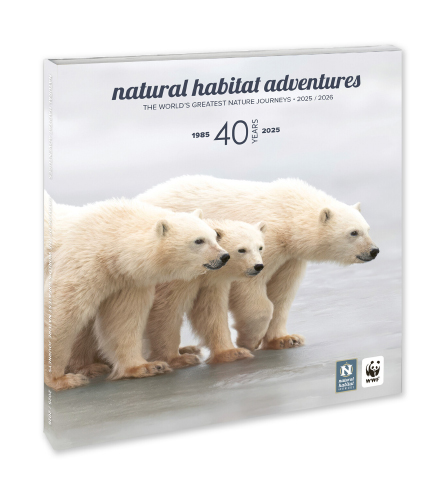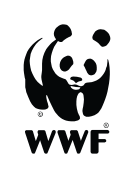Did you know that globally, women are more affected by biodiversity loss and climate change than men?
From resilience in the face of natural disasters to access to water and other natural resources, studies clearly illustrate that women and girls suffer disproportionately from the effects of climate change, exacerbating gender inequality and creating additional health and safety challenges.
Supporting women in conservation can make a transformational difference in individuals’ lives and strengthen whole communities.
Here are five reasons (and a great way) to support the work of women in conservation, featuring conservation initiatives.
Women in Conservation: Stewards of the Environment
“African women are the natural custodians of the environment. They pay the price when it comes to the social and economic effects of factors associated with environment and conservation.” —Fiesta Warinwa, Director of Policy Engagement, African Wildlife Foundation

Women farmers in Uganda © Richard de Gouveia
One recent study found that forest patches managed by women had 51% less deforestation than those managed by men. Over 80% of the world’s remaining forest biodiversity is within the lands of Indigenous peoples who have protected them for generations. Indigenous women and women in the Global South have long acted as stewards of the environment through their traditional roles as healers, culture shapers, and caretakers of water and land.
WWF supports women’s groups in Nepal in building upon that role by including women in managing community forests and wildlife corridors, protecting endangered species such as tigers and rhinos, and generating income from ecotourism and handicrafts.
Women Can Drive Sustainable Food Systems
Another area where women can make a difference in conservation is agriculture. Women smallholder farmers produce 60 to 80 % of all food in low-income countries, often on five acres of land or less. Managing 70% of smallholder farms in Africa, women provide more than half of all nutrition to people on the continent!
Project Drawdown, one of the world’s leading resources for action-based, existing solutions to climate change, estimates that providing resources, financing, and training to women smallholder farmers can reduce 2.1 gigatons of carbon dioxide by 2050 by improving agricultural yields and reducing deforestation.
Still, women routinely face barriers such as limited access to land rights, credit, capital, training, tools and technology, preventing them from achieving their full potential and adopting more sustainable farming practices.

Women harvesting rice
“Ending gender inequity is not just the right thing to do, it is the smart thing to do. FAO tells us giving women farmers access to the resources they need would lift up to 150 million people out of hunger.” — Ertharin Cousin, Former Executive Director of the World Food Program
According to the UN, women can increase agricultural yields by 20-30% when provided the same resources as men, reducing hunger by 12-17%.
Greenhouses at the Kambuku Cooperative in Lilongwe, Malawi, are a fantastic example. The greenhouses were designed to address climate change and gender-based inequalities women farmers face. Women constitute 70% of full-time farmers in Malawi and produce more than 80% of subsistence crops. Although farmers in the country typically rely on rain, the country is prone to dry spells, intense rainfall, pests and disease outbreaks, all of which are worsened by climate change.
Over 72% of the Kambuku Cooperative’s members are women. They grow tomatoes, green peppers, leafy vegetables and strawberries that are more climate-resilient for their region in these innovative greenhouses, generating over 14 million Malawi Kwacha (USD 517,000) between 2020 and 2023. The group used that money to contribute to the building of a warehouse to store their products and bought extra water pumps.
In early 2024, the cooperative won a one-year contract of 500,000 Malawi Kwacha (USD 18,500) to provide leafy vegetables to schools in Lilongwe.

Malawi children pumping potable water
“Investing in women farmers who are the backbone of our agriculture sector is key to ending poverty.” — Esnart Kalunga, Malawi Agriculture Extension Officer, Lilongwe East
Educating Women and Girls Is Climate Change Mitigation
“I believe the most important thing we can do for conservation worldwide is to invest in the training of men and women to manage their own natural resources.” — Russell E. Train, Founder and former Chairman Emeritus of World Wildlife Fund

The Library for Galapagos (Biblioteca para Galapagos) proudly stands as the sole communal library within the Galapagos Islands. In 2023, aid from Nat Hab has kept the library’s doors open and its mission thriving.
According to Project Drawdown, advancing key areas of gender equity can reduce emissions significantly. For example, providing equal quality and access to education to girls and young women can lead to improved livelihoods, delayed onset of marriage, delayed childbearing, and fewer children than peers with less education. This can result in lower population growth and lower demand for resources that contribute to greenhouse gas emissions. Project Drawdown estimates educating girls can avoid 51.48 gigatons of carbon dioxide by 2050.
“Education can decrease vulnerability to climate-related events such as extreme heat, flooding, and resource scarcity and increase climate adaptation and resilience.” —Project Drawdown

By empowering women and girls to access education, family planning and agricultural resources, WWF and Project Drawdown are not only advancing human rights and social justice but also contributing to the protection of biodiversity and the mitigation of climate change. Women are essential to conservation and deserve recognition and support for their efforts.
In 2023, WWF recognized the work of Charatie Ropati, a 22-year-old Yup’ik and Samoan woman, who developed an inclusive and historically accurate sub-curriculum on Indigenous peoples for the Anchorage School District, highlighting the traumatic history of colonization and its impacts on today’s Native communities. Ropati’s research examines how the climate crisis affects plant ecology in Alaska and how this relates to cultural resilience.
Ropati highlights that only 0.3%-0.5% of science and engineering degrees are held by Native Americans or Alaska Natives, which is significantly lower than the total percentage of this ethnic group in the US.

Churchill Community Complex School © Megan Brief
Women’s Entrepreneurship Fuels Sustainable Development
Women’s economic activity has a positive knock-on effect on families and whole communities regarding literacy and educational outcomes, public health, and serving as role models for other girls and women in ways that male founders or entrepreneurs do not.
“When women do better, economies do better.” — Christine Lagarde, President of the European Central Bank.

Woman basket weaver, Thailand
Women’s economic involvement, whether it’s ecotourism or other sectors, leads to more sustainable and resilient communities. Women owners reinvest up to 90% of their income back into their families and communities, compared to 30-40% for men.
Women-owned entities represent just over 30% of registered businesses worldwide. Increasing women’s participation in the labor force to the same level as men could raise GDP by up to 34% in some countries.
There is a $1.5 trillion annual credit deficit for women-owned SMEs in emerging markets. Sustainable, equitable funding for women-led initiatives and endeavors could help to close this gap.
Women in Conservation Leadership Roles
When more women are involved in group decisions about land management, the group conserves more. A CU Boulder study of 440 forest users from three developing countries sheds new light on the role gender plays in local governing bodies in reducing global deforestation and greenhouse gas emissions while also curbing local inequalities.

Samoyed woman gathering natural resources in the high Arctic
“When policymakers think about what to do to increase conservation around the world, gender quotas don’t even come up as a viable policy instrument,” said senior author Krister Andersson, a political science professor and researcher at the CU Boulder Institute of Behavioral Science. “This study suggests they should.”
Similarly, a study in India found that with a high proportion of women in leadership, regeneration rates and canopy growth increased even when established in smaller and more degraded forests.
Research has also shown that women adopt innovative and preventative measures faster than men. In a review of 17 studies from around the world, the presence of women in conservation and natural resource management resulted in stricter and more sustainable extraction rules, greater compliance, more transparency and accountability, and better conflict resolution.
This research has shown that women tend to think for the collective whole rather than themselves—making more decisions that support the public good, provide fair pay and benefits, and encourage honest and ethical behavior.
“When we invest in women and girls, we are investing in the people who invest in everybody else.” —Katharine Wilkinson, Project Drawdown, TED Talk

Indigenous storyteller in Greenland © Eddy Savage
Studies show that where women have higher social and political status, their countries have 12% lower CO2 emissions. They also create and improve climate change policy more often than men. A study of 130 countries showed that nations with a high representation of women in their administrations are more likely to ratify international environment treaties. Another study found that gender-diverse teams even produce more impactful science!
And yet, women hold only 12% of the world’s top conservation leadership positions. Despite women’s critical roles in communities in many rural areas of developing countries—from food production and water management to child-rearing and making and selling goods—women are consistently underrepresented and face barriers to participating in natural resource management and climate adaptation decision-making from local to global levels.
One way WWF supports youth leaders in conservation is through an annual Conservation Leadership Award recognizing young leaders, many of whom are Indigenous women in environmental science and activism.
Nat Hab is committed to supporting and celebrating women’s achievements in conservation.

Nat Hab Expedition Leader Judy Wilson guiding our Belugas, Bears & Summer Wildlife of Churchill adventure © Judy Wilson
How Travel Can Support Women in Conservation
When you travel with WWF through Natural Habitat Adventures, you join us as a force for change in addressing the most pressing conservation challenges around the world. Together, we are pioneering conservation travel, which is sustainable travel that supports the protection of nature, wildlife and local communities. Your trip helps us transform the future of nature.
Since 2003, Nat Hab has partnered with WWF to promote this mission, providing over $6 million to support WWF’s global conservation efforts, including the awards, scholarships, and initiatives included above. Nat Hab will continue to give 1% of gross sales plus $174,000 annually through 2028 to support WWF’s mission to conserve nature and reduce the most pressing threats to the diversity of life on Earth.
Nat Hab guests have donated an additional $40 million in support of WWF priorities in some of the planet’s most precious and imperiled places. WWF currently has over 2,000 conservation projects in progress around the world.

Nat Hab Expedition Leaders, Base Camp Greenland © Fiona Galbraith
Did you know Nat Hab has a series of for-women, by-women trips called Women’s Journeys? These adventures are led by top female Expedition Leaders and offer a chance to explore with local women who join as regional guides and special guests. The itineraries have a special focus on the contributions of women in the destinations—as pioneers, Indigenous leaders, rangers, researchers, conservationists, explorers, entrepreneurs, educators and more.



























